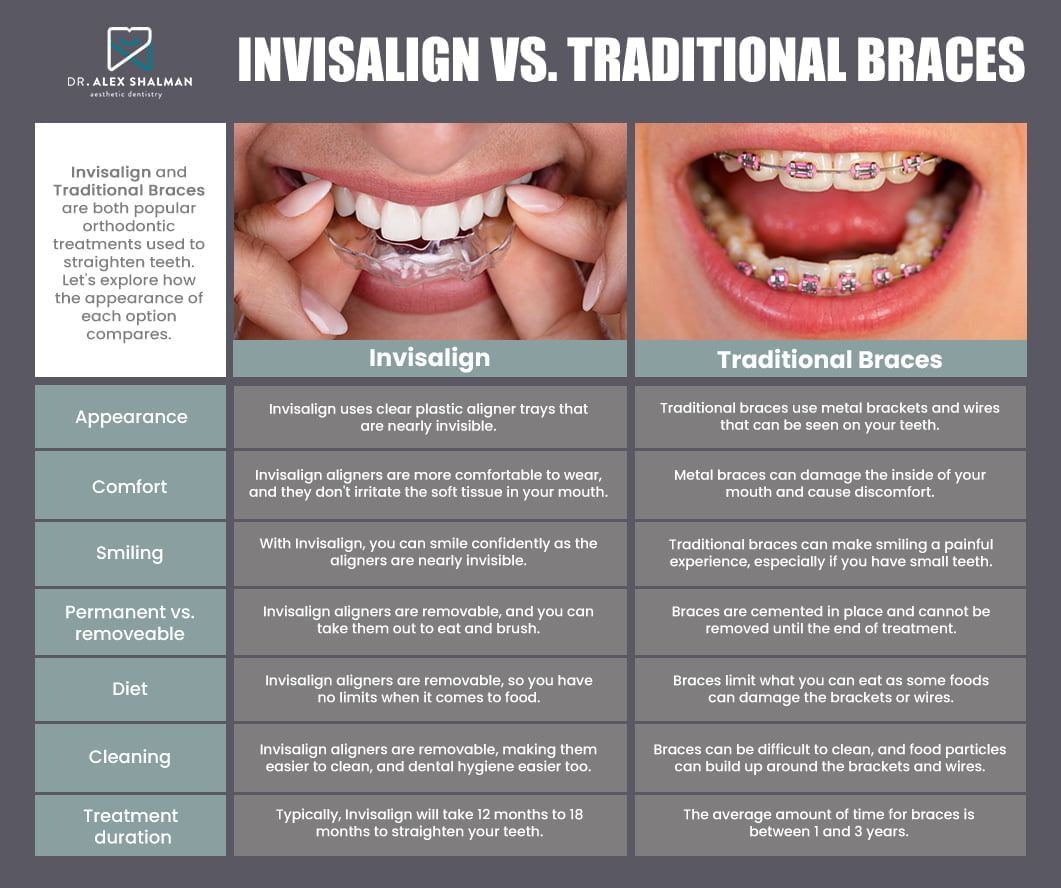Top Reasons to Pick Invisalign Over Other Orthodontic Treatments
Top Reasons to Pick Invisalign Over Other Orthodontic Treatments
Blog Article
Invisalign vs. Typical Dental braces: Which Choice Is Right for You?
When considering orthodontic treatment, the selection in between Invisalign and traditional dental braces offers numerous crucial variables that merit mindful evaluation. Invisalign supplies a discreet choice with removable aligners, while traditional braces provide an extra noticeable yet reliable service for extreme misalignment. Each option includes distinctive advantages and drawbacks associated with aesthetic appeals, convenience, treatment duration, and price. Comprehending these subtleties is essential for making a notified decision that lines up with your individual preferences and lifestyle. The concern remains: which choice will finest fulfill your orthodontic needs and expectations?
Summary of Treatment Choices

In contrast, standard braces contain steel brackets and cords that are adhered to the teeth. This approach applies continual stress with time to accomplish placement. While reliable for complicated orthodontic concerns, standard braces call for routine brows through for modifications and can present challenges in preserving dental hygiene due to the problem of cleansing around braces and cables.
Both alternatives have their advantages, and the choice frequently rests on details dental problems, way of living choices, and person conformity. Eventually, seeking advice from an orthodontic professional is critical for determining one of the most ideal therapy strategy tailored to private needs. Comprehending the subtleties of each alternative can considerably affect the total success of orthodontic therapy.
Visual Considerations
A significant variable influencing the option between Invisalign and conventional braces is the visual charm each therapy uses. Invisalign aligners are crafted from clear plastic, making them essentially unnoticeable when worn.
In comparison, standard braces consist of metal brackets and wires, which can be extra obvious. While improvements in orthodontic technology have actually led to the advancement of smaller braces and tinted elastics, typical dental braces still maintain a more conspicuous profile. For some people, the presence of braces may prevent them from looking for needed treatment.
Eventually, the option in between Invisalign and standard braces might rest on personal choices pertaining to aesthetics. People who focus on discernment usually favor Invisalign, while those who are much less concerned concerning visibility might choose standard dental braces. Comprehending the aesthetic implications of each choice is vital for making an informed decision that aligns with one's lifestyle and choices.
Comfort and Convenience

In terms of comfort, Invisalign aligners are removable, allowing patients to appreciate their favored foods without limitation and keep ideal dental hygiene. Cleaning and flossing are streamlined, as the aligners can be taken out during these regimens, whereas conventional braces require cautious steering around brackets and cords.
In comparison, typical braces review necessitate regular modifications, making them much less convenient for those with active timetables. Overall, the convenience and ease of Invisalign make it an appealing option for many individuals seeking orthodontic therapy.
Treatment Period and Efficiency
While both Invisalign and conventional dental braces are effective in fixing dental misalignments, the period of treatment can vary substantially between both choices. Commonly, Invisalign therapy can take anywhere from 12 to 18 months, depending upon the intricacy of the instance. The clear aligners work by slowly shifting teeth into their wanted positions, and routine follow-ups with an orthodontist help ensure development stays on track.
On the other hand, conventional dental braces typically require a longer dedication, usually ranging from 18 months to 3 years. This results from their fixed nature and the usage of cables and brackets, which can be a lot more effective for serious imbalances and complicated instances (Invisalign). The therapy efficiency of typical dental braces is well-documented, as they enable specific changes and greater control over tooth activity
Eventually, the selection in between Invisalign and conventional dental braces may depend upon both the awaited therapy duration and the particular oral issues at hand. Consulting with an orthodontist is critical, as they can offer tailored referrals based on specific needs, making certain the selected approach straightens with wanted outcomes and durations.
Expense Contrast and Insurance Coverage Options
Price plays a significant role in the decision-making procedure for individuals taking into consideration orthodontic treatment, whether going with Invisalign or typical braces. On average, the cost of Invisalign arrays from $3,000 to $8,000, while typical dental braces usually cost in between $2,000 and $6,000. Aspects affecting these expenses include the complexity of the situation, the period of therapy, and geographical location.
Insurance insurance coverage can considerably affect out-of-pocket costs. Lots of dental insurance coverage plans give partial coverage for orthodontic treatments, however the specifics can differ widely. It is vital for directory individuals to examine their insurance coverage to identify the level of insurance coverage for either choice. Normally, conventional dental braces might be extra frequently covered by insurance plans compared to Invisalign, which some insurance providers classify as an aesthetic procedure.
Additionally, numerous orthodontic practices use versatile layaway plan, making both therapy options much more available. People should inquire concerning possible financing alternatives and discount rates for upfront repayments. Evaluating the overall price, including insurance coverage benefits and payment plans, is essential for making an educated decision that lines up with both visual choices and spending plan considerations.

Verdict
In summary, the selection between Invisalign and typical dental braces depends upon several aspects, consisting of visual choices, comfort, therapy period, navigate here and cost. Invisalign uses a very discreet, detachable alternative that facilitates oral hygiene and nutritional adaptability, while typical dental braces may be better for complex oral concerns and often come at a lower cost point. Inevitably, assessment with an orthodontist is necessary to evaluate specific situations and establish one of the most proper treatment choice for achieving optimum oral positioning.
When thinking about orthodontic treatment, the selection between Invisalign and standard dental braces offers a number of vital elements that merit mindful analysis.Contrasting Invisalign and typical braces exposes unique treatment alternatives for orthodontic adjustment.While both Invisalign and typical braces are effective in dealing with dental imbalances, the duration of treatment can vary considerably in between the 2 options.Cost plays a significant function in the decision-making procedure for people thinking about orthodontic treatment, whether choosing for Invisalign or standard dental braces.In summary, the choice in between Invisalign and standard braces hinges on several factors, including visual preferences, convenience, treatment period, and expense.
Report this page